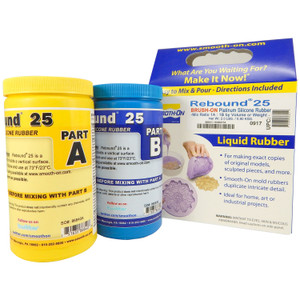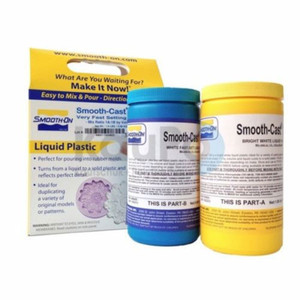
Smooth-On OOMOO 25, Trial Size
$28.61
From Smooth-On
Easy to use silicone mold making rubber suitable for a variety of art-related and industrial applications including making molds for sculpture and prototype reproduction, casting plaster, resins and wax.
OOMOO 25 from Smooth-On is an easy-to-use 2-part mix with convenient one-to-one by volume mixrations, meaning no scales necessary. Very low viscosity for easy mixing and pouring. Works well for a variety ofart related and industrial applications including making molds for sculpture and prototype reproduction, casting plaster,resins and wax. OOMOO 25 has a 15-minute pot life and a 75 minute cure time.2-part system is 2.8 lbs. total.
Instructions
- Safety Use in a properly ventilated area room size ventilation). Wear safety glasses, long sleeves, and rubber gloves to minimize contamination risk. Wear vinyl gloves only. Latex gloves will inhibit the cure of the rubber.
Store and use material at room temperature (73F/23C).??Storing material at warmer temperatures will also reduce the usable shelf life of any??unused material. These products have a limited shelf life and should be used as soon as possible.Premix Parts A and B thoroughly before using. - Cure Inhibition- Silicone rubber may be inhibited by certain contaminants in or on the pattern to be molded, resulting in tackiness at the pattern interface or a total lack of cure throughout the mold. If compatibility between the rubber and the surface is a concern, a small-scale test is recommended. Apply a small amount of rubber onto a non-critical area of the pattern. Inhibition has occurred if the rubber is gummy or uncured after the recommended cure time has passed. Materials found to cause cure inhibition include sulfur-based modeling clays and latex rubber.
Note: To prevent inhibition apply a sealing agent. - Applying a Release Agent- Although not usually necessary, a release agent will make demolding easier when pouring into or over most surfaces.
Because no two applications are quite the same, a small test application to determine suitability for your project is recommended if theperformance of this material is in question. - Measuring & Mixing strong>Before you begin, pre-mix Parts A and B thoroughly.After dispensing equal amounts of Parts A and B into the??mixing container, mix thoroughly for 3 minutes making sure that you scrape the sides and bottom of the mixing container several times. The mixture should have a uniform color with no color streaks. If you observe color streaks, continue mixing until they are eliminated.
- Pouring
- CuringAllow mold to cure for 75 minutes at room temperature (73F/23C) before demolding. Post curing the mold an additional 4 hours at 150F (65C) will eliminate any residual moisture and alcohol which is a byproduct of the condensation process and may inhibit some resins. Allow mold to cool to room temperature before using. Do not cure rubber where the??temperature is less than 65F/18C.
- Using The Mold
- Mold Performance & Storage
$28.61






